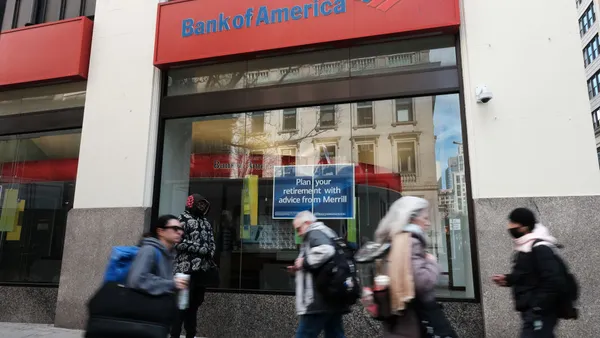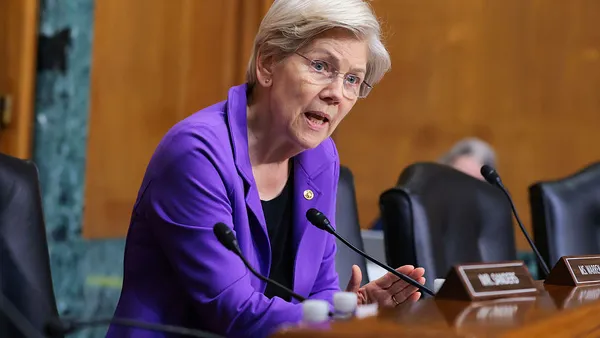What is earnings season but controlled gambling?
Banks and other companies measure themselves against not only their previous results but against predictions from analysts.
Some gambles pay off — or don’t — in the short term. Others become pegs in a longer-term strategy.
Wells Fargo saw one of each in its quarterly earnings Friday. The bank reported a short-term surprise — $576 million in impairment of equity securities, deriving mostly from affiliated venture capital business.
But executives also laid out their long-term thoughts regarding a business segment in a bit of a tailspin. Mortgage-banking income dropped 79% in the quarter, to $287 million — a far cry from the $392.4 million analysts estimated, according to Bloomberg. That plunged the bank’s home-lending income to $972 million — a 53% decline from the nearly $2.1 billion the bank netted in last year’s second quarter.
Wells Fargo has launched at least two rounds of layoffs since April in home lending, affecting nearly 200 workers in Iowa — where the bank’s home mortgage division is based.
The bank’s CFO, Mike Santomassimo, left open the possibility for more job cuts. “We are making adjustments to reduce expenses in response to lower origination volumes, and we expect these adjustments will continue over the next couple of quarters,” he said Friday, according to American Banker.
At the same time, Wells has prioritized its existing mortgage customers, CEO Charlie Scharf said, but would add to its user base “to the extent that we have efficiencies.”
“We're not interested in being extraordinarily large in the mortgage business, just for the sake of being in the mortgage business,” Scharf said, according to American Banker. “We're in the home lending business because we think home lending is an important product for us to talk to our customers about, and that'll ultimately dictate the appropriate size of it.”
Scharf has scrutinized the makeup of the bank’s business since taking its top role in 2019 and has regularly sought to offload segments deemed “non-core.”
However, refinancing — one source of existing-customer revenue — is relatively drying up. About 28% of the bank’s mortgage originations in second quarter came from refinancing, compared with 59% as of December. Rising interest rates are no doubt at least somewhat to blame for the refi drought.
Low-stakes bets
Elsewhere on its balance sheet, Wells Fargo added $580 million to its loan-loss reserves — roughly the same amount the bank lost in relation to equity securities.
The pandemic has shown that loan-loss reserves are fairly low-stakes, as bets go. Provided that analysts initially overestimate potential losses, the bank can simply pump excess reserves back into gen-pop once the financial threat subsides. Wells Fargo, for example, released $1.6 billion of its loan-loss reserves during last year’s second quarter, and big banks since then have generally continued working down the rainy-day funds they amassed at the start of COVID-19.
Wells would not be alone in ramping up their reserves. JPMorgan Chase built up its reserves by $428 million in the second quarter, it reported Thursday. Citi, meanwhile, squirreled away $375 million in reserves. By contrast, Bank of America on Monday announced it had released $48 million of its reserves during the second quarter. In another three months, observers may start to see whose philosophy wins out.
Or maybe everything’s subject to change
Still other banks found alternate methods to optimize their balance sheets. State Street said Friday it is looking to amend the terms of its proposed acquisition of Brown Brothers Harriman’s investors services business — including the purchase price, set at $3.5 billion when the deal was announced last September.
State Street wants to preserve the economic accretion it targeted when the deal was first announced, CFO Eric Aboaf said Friday. That may involve changing the structure or operating model of the combined entity. But that, too, is not without its risks.
"The regulatory world and the political world has changed significantly since we announced this deal and what we're looking towards [is] a way to break through and close it in a reasonable time period," State Street CEO Ronald O'Hanley said, according to S&P Global.
The transaction’s closing has already been delayed by months, and the parties are now aiming to close the deal by the end of this year.
"This time period doesn't seem reasonable to anybody, but it's actually better than some of the alternatives that we've been faced with,” O’Hanley said.
If State Street and Brown Brothers Harriman can’t agree on updated terms by Sept. 6 — one year after the proposal was announced — either can terminate the deal without penalty.











